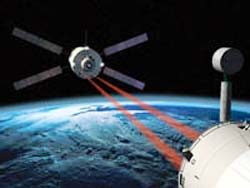This area deals with the fundamental laws and building blocks of nature and how they interact, the properties and the behavior of matter, and research into space and time and their structures.
innovations-report provides in-depth reports and articles on subjects such as astrophysics, laser technologies, nuclear, quantum, particle and solid-state physics, nanotechnologies, planetary research and findings (Mars, Venus) and developments related to the Hubble Telescope.

One of Britain’s leading climate change experts has thrown his weight behind the claim that global warming is being caused by human activity in a report published today by the Institute of Physics.
The report by Professor Alan Thorpe, who takes up his post as chief of the Natural Environmental Research Council next month, aims to tackle sceptics who doubt the models scientists use to predict future climate change.
Professor Thorpe outlines the scientific basis for

Say “nanotechnology” and people are likely to think of micro machines or zippy computer chips. But in a new twist, Rutgers scientists are using nanotechnology in chemical reactions that could provide hydrogen for tomorrow’s fuel-cell powered clean energy vehicles.
In a paper to be published April 20 in the Journal of the American Chemical Society, researchers at Rutgers, The State University of New Jersey, describe how they make a finely textured surface of the metal iridium

The last outstanding hardware needed before arrival of the Automated Transfer Vehicle (ATV), the European-built ISS supply ship due for launch in 2006, has been installed outside the International Space Station (ISS) during a 4 1/2 hour Extra Vehicular Activity (EVA) on Monday 28 March.
The two ISS Expedition 10 crewmembers, Commander NASA astronaut Leroy Chiao and Flight Engineer Russian cosmonaut Salizhan Sharipov, who was the operational lead for the EVA, installed the l

In the March 25th 2005 issue of Science Magazine, the High Energy Stereoscopic System (H.E.S.S.) team of international astrophysicists, including UK astronomers from the University of Durham, report results of a first sensitive survey of the central part of our galaxy in very high energy (VHE) gamma-rays. Included among the new objects discovered are two ‘dark accelerators’ – mysterious objects that are emitting energetic particles, yet apparently have no optical or x-ray counterpart.

In orbit for three and a half years now, ESA’s smallest Earth Observation satellite is making a big contribution to science, a workshop heard this week. Proba applications range from studying land vegetation to water quality monitoring, assessing productivity of Italian vineyards, even helping hunt for meteorite impact craters.
ESA’s Proba microsatellite is about the same size and shape as a washing machine. It was launched on 22 October 2001 as a one-year technology de

Researchers from St. Petersburg have ascertained that formation of a child’s sex depends, among other things, on the geomagnetic field status at the time of conception.
Who will be born – a boy or a girl? The answer to this question that worries all parents is determined by a lot of conditions, including external ones. The scientists of the Central Scientific-Research Institute of Radiology and Nuclear Medicine, Ministry of Health Care of the Russian Federation (St. Petersburg)